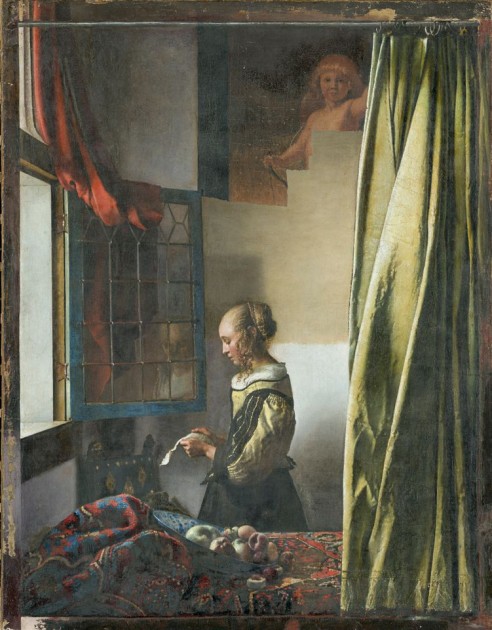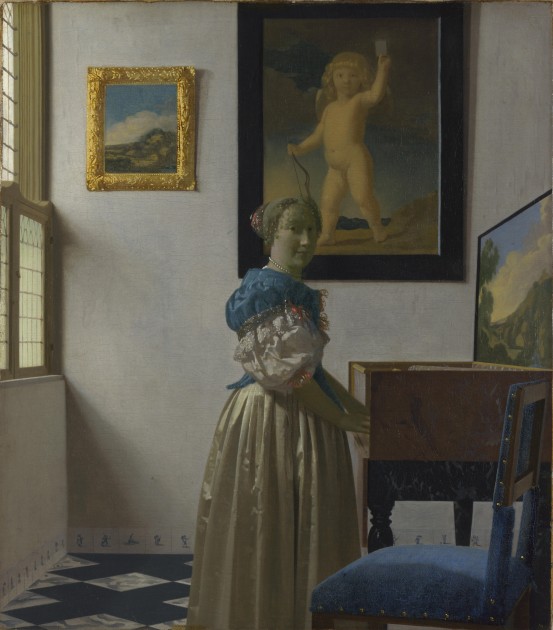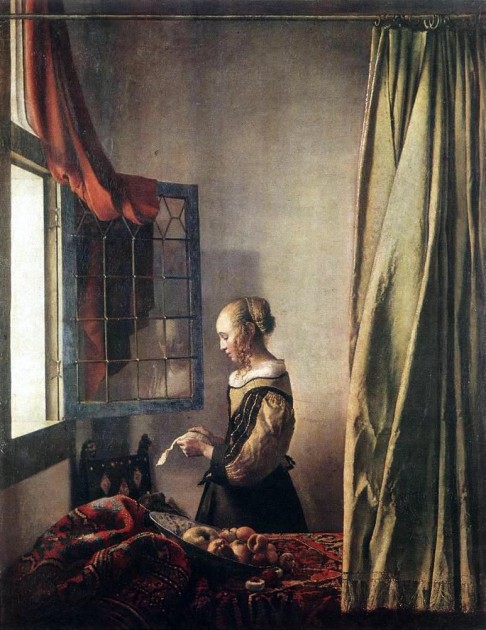Monday, May 13th, 2019
Vermeer’s Cupid Revealed!

Vermeer, “Girl Reading a Letter at an Open Window,” (with recent restoration revealing image of Cupid), c. 1658. Gemäldegalerie Alte Meister, Dresden
Like many other art historians, I have been fascinated by the recent article in The Art Newspaper which announced that a hidden figure of Cupid has, though restoration work, become visible in Vermeer’s painting Girl Reading a Letter at an OpenWindow. This image of Cupid has been known for about forty years due to x-ray scans, but it was thought to have been overpainted by Vermeer himself. However, new studies have revealed that the Cupid was painted out of the scene several decades after Vermeer had died.
This figure of Cupid is actually familiar to those familiar with Vermeer’s art: it also appears in another painting by Vermeer, A Lady Standing at a Virginal (1670, shown below). In fact, Vermeer placed Cupid in almost the same compositional place as Girl Reading a Letter at an Open Window. Vermeer would often use similar props or compositional devices in his paintings, so the discovery of this new Cupid is consistent with what we have know about Vermeer’s work. There is even a “Cupid” item that is listed in Vermeer’s inventory, so he may have owned this painting himself.
I have a strong hunch that the Cupid figure was taken out of Girl Reading a Letter at an Open Window in order to make it more salable. As an artist, Vermeer fell into obscurity after his death. Art dealers in the 18th and 19th centuries reattributed to his paintings to better known artists from the 17th century, likely due to lack of information, but it also undoubtedly in an effort to make more money.1 For example, Girl Reading a Letter at an Open Window was thought to be a painting by Rembrandt when it was acquired by the Elector of Saxony in 1742.2 It seems likely to me that the Cupid was painted out sometime before the Elector of Saxony purchased the painting, since Rembrandt often has muted, dark backgrounds that don’t include framed paintings of Cupids. It makes sense to me that a dealer might encourage the Cupid to be painted out, in order for the attribution to seem more plausible.
Perhaps this Cupid figure – despite being covered up with paint – has helped imbue this painting with a bit of luck over the centuries: Girl Reading a Letter at an Open Window was hidden for safekeeping during World War II and escaped destruction during the massive bombing of Dresden in 1945. Later that year the painting was seized by the Red Army and taken to Russia as booty. After the war, the Soviet Minister of Culture wanted to East Germany to keep this painting in Russia as a token of gratitude for Russian assistance, but the proposal was dropped and the painting returned to Dresden in 1955. I remember specifically going to the Gemäldegalerie Alte Meister in Dresden in August 2017 to see this painting, but I was disappointed to learn that it had been taken off of view for conservation purposes – my guess is that they already were working to clean this painting and reveal this Cupid figure back then.
Which Girl Reading a Letter at an Open Window do you prefer? The newly-restored version (shown at the top of the pose) or the overpainted version (shown below)? I have to admit, it will take a while for me to get used to the fact that this girl is no longer reading her letter “by herself” in visual isolation – there is another commanding figure in the room! Hopefully I’ll get more adjusted to the appearance over the next year; it is expected to take that long for all of the overpaint paint to be removed from the Cupid figure.
1 The painting was also described as being “in the manner of Rembrandt” in 1747 and then in 1801 was described as the work of Rembrandt’s pupil Govaert Flinck. Between 1826-1860, the painting was attributed to the domestic painter Pieter de Hooch, with the correct attribution to Vermeer not appearing until 1862. For more information, see Arthur K. Wheelock, ed., Johannes Vermeer (Washington, D. C.: National Gallery of Art and Yale University Press, 1995), 56-57. Available online here: https://www.nga.gov/content/dam/ngaweb/research/publications/pdfs/johannes-vermeer.pdf
2 For more information on art dealers and their effect on Vermeer’s posthumous reputation, see Emma Barker’s “The Making of a Canonical Artist: Vermeer” in The Changing Status of the Artist (Open University Press, 1999), 201-4. Limited preview available here: https://books.google.com/books?id=A_1Ady0GAuUC&lpg=PP1&dq=changing%20status%20of%20the%20artist&pg=PA204#v=onepage&q&f=false

